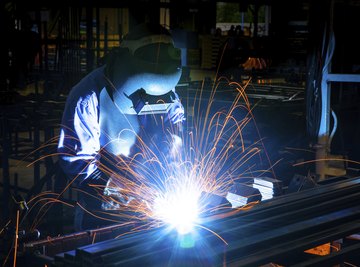
Welding is the joining of two or more metal parts by melting them together. This process is unlike soldering, which is simply attaching two metal surfaces together via a piece of molten metal. Because the melting points of most metals are so high, specialized welding equipment uses the heat from an electric current to weld metal together.
Welding Arc, Filler Metal and Shielding the Weld
There are three main aspects to the welding process: the welding arc, filler metal and shielding the weld. A welding arc is a continuous spark that is generated by a welding machine and is used to heat the metal by several thousand degrees Fahrenheit. The spark is created by a circuit that passes from the machine through the metal being welded. Filler metal is additional metal added during the weld to strengthen the welded joint. A weld must be shielded from the surrounding air until it sets, as air can contaminate the weld. This shielding is accomplished by adding shielding gas to the process, provided by either a tank attached to the welding machine or a specially formulated filler metal that releases the gas as it melts.
Welding Arc Polarity
Like any electrical current moving through a circuit, a welding arc has polarity, with a positive and negative pole. Polarity has a significant effect on the strength of a weld. Electrode-positive, or reverse, polarity causes a deeper penetration of the weld then electrode-negative, or positive, polarity. However, electrode-negative polarity results in a faster deposition of the filler metal. When using direct current, the polarity is always constant. With alternating current, the polarity switches 120 times per second in a 60-hertz current.
Which is Better?
For all intents and purposes, DC welding is the preferred type of welding. Whether you are using electrode-positive (DC+) or electrode-negative (DC–) polarity, DC tends to produce a smoother weld than AC. Whereas DC delivers a constant and consistent current, the nature of AC means that it delivers a current that constantly swings back and forth from positive to negative. As the current swings back and forth, it must pass through a point at which there is zero current output. Although the current is only at this zero point for a fraction of a second, the disruption can be enough to disrupt the arc, causing it the fluctuate, flutter or extinguish completely.
When is AC Used?
Because AC welding is significantly inferior to DC welding, it is only used in rare circumstances. AC welding machines are most frequently used when there is no DC machine available. Derisively referred to as "buzz boxes," AC welding machines are considered entry-level technology. AC welding might also be used to fix arc blow problems. This phenomenon is marked by an arc that wanders or blows out the joint being welded. This usually happens when working with large-diameter electrodes at high current levels.
References
About the Author
Brett Smith is a science journalist based in Buffalo, N.Y. A graduate of the State University of New York - Buffalo, he has more than seven years of experience working in a professional laboratory setting.
Photo Credits
Easy_Company/iStock/Getty Images
